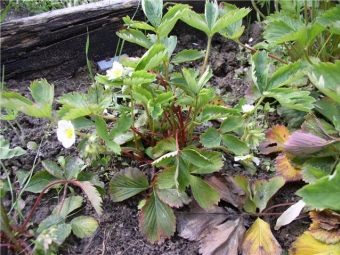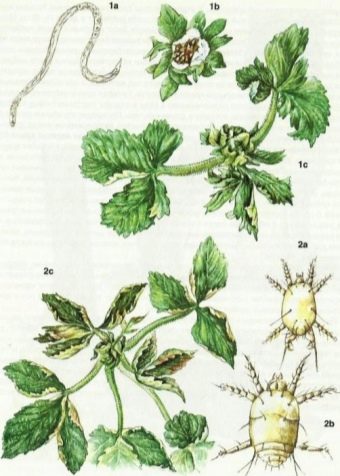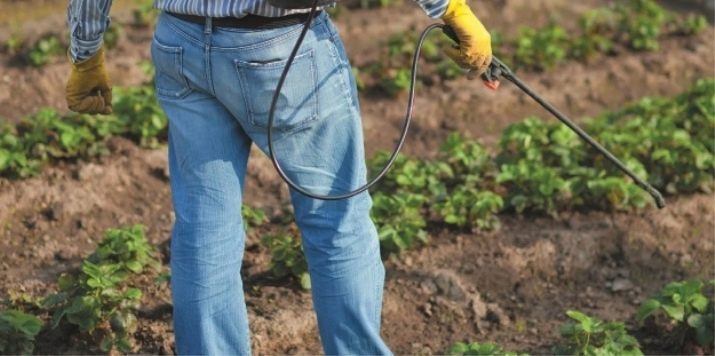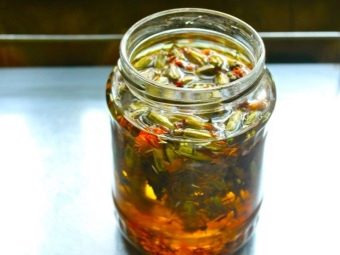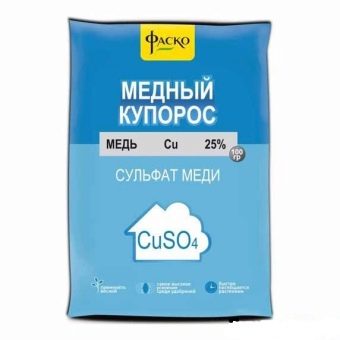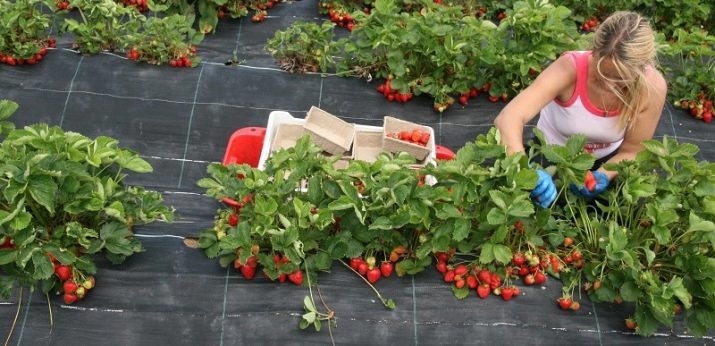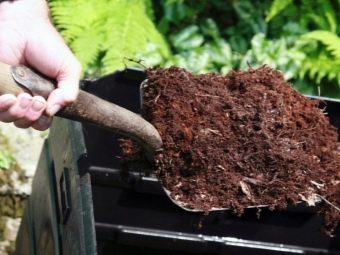Strawberry nematode: lesion symptoms, control and prophylaxis
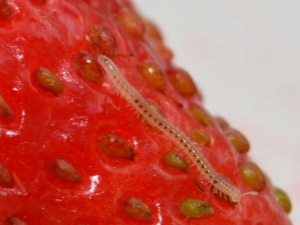
One of the most delicious and juicy berries is strawberries. It is grown almost all summer residents on their sites. Unfortunately, not only people like to eat strawberries, but also harmful organisms. These include strawberry nematode. This type of worm eats not only strawberries, but also other berries: raspberries, strawberries, and also "attempts" on chrysanthemums. It is quite simple to detect a nematode: the presence of tubules from leaves on a plant and the formation of dark specks indicates the appearance of nematodes.
Signs of infection
Strawberry nematode - a worm with a roundish shape and a yellowish tinge. The length of the body reaches only 1 mm, however, these worms pose a great danger to the fruit. In the oral cavity of the nematode is an organ that looks like forceps. They help the parasite to gain a foothold on the stem or root of the plant. After that, the worm releases some liquid from itself, which leads to the formation of a reaction, due to which the garden culture begins to attract the parasite.
The main distinguishing feature of a parasitic worm is that it is almost impossible to recognize it in the early stages of a lesion. Only by digging up the root of a plant, you can clearly see the parasite.
Recognize the defeat on strawberries can be on the following grounds:
- slow growth and root formation;
- the presence of a large number of white cysts;
- yellow shade of the leaves of the plant;
- folding leaves into tubes;
- vein thickening;
- slow formation of stems and leaves;
- stopping or slowing the flowering plants;
- Strawberry shape change, reduction in size.
One worm can parasitize on several plants simultaneously. Due to the invasion of nematodes, the strawberry dries and gradually dies. The danger of parasitic worms is that they carry various infections and fungi. Nematodes are also detected in the following way. Flowers and leaves of a plant are crushed and lowered in water. After some time, worms in the form of thin white threads will be visible in the container. Bushes of strawberries resistant to the invasion of parasitic worms do not exist. However, breeders were able to bring some varieties of plants that have stronger immunities to nematodes.
These varieties include varieties:
- Saxon;
- "Dessert";
- "Rocket";
- "Granddaughter";
- "Festival";
- "Pearl oyster".
Methods of struggle
You need to know that completely get rid of parasitic worms will not succeed, but thanks to folk remedies and drugs can significantly reduce their number.
When destroying strawberry nematodes, the following mistakes should not be made.
- Spraying with insecticides and products not intended to get rid of parasites. Similar procedures only help in the destruction of insects, but not nematodes.
- Release of contaminated plants into compost to turn into humus. As a result, nematodes do not die, but multiply for many years and infect with humus.
- Many gardeners do not pay special attention to the poor appearance of plants infected with parasitic worms. In this case, the nematodes will not leave the strawberry bush alone, until the plant finally dries out, after which they freely move to another bush.
Therefore, the affected plants must be destroyed in time, without waiting for the defeat of the whole bed.
Folk remedies
In the absence of special medicines, you can resort to the popular methods of treatment of nematodes. Thanks to simple recipes, you can cure the diseases of fruit plants without the risk of losing yield.
These measures include the following.
- Boiled water very effectively eliminates parasitic worms. For treatment, it is necessary to dig the affected plants and dust them from the soil, then rinse under running water. It is also necessary to pour water heated to 47 degrees into a clean pot and lower the strawberry roots for 15 minutes.With the onset of adult worms, you can do with water heated to only 40 degrees and lower the roots for only 10 minutes. If nematode eggs are destroyed, the water heats up to 55 degrees and the roots descend for a third of an hour. In this case, the important point is the exact observance of thermal mode. Otherwise, you can scald the roots of the plant, causing it to die.
- The infusion of marigolds is a killer poison for most pests. To prepare the juice, 1 kg of flowers pour in liters of water and leave for a couple of days. After the end of this period it is necessary to spray strawberry beds.
- Infusion of calendula is considered no less effective way to get rid of pests. To prepare the broth pour 5 liters of water 200 grams of dried flowers of calendula. Infusion should be in a warm environment for a day. This means plentifully water plants once a week.
- Infusion nasturtium prepared as follows. The crushed 300 grams of a plant is filled in with water of 5 liters. The solution is infused for 24 hours, then watered once a week.
- Nettles in a large container pour boiled water and leave for 3 days. After filtering it is necessary to water the plants. Such a solution will destroy the parasites present on the roots of strawberries.
- Onion-batun weighing about 200 grams is cut into pieces and filled with water of 4 liters. Such infusion strawberry beds are treated 1 time per week.
- Hogweed pour water in the ratio of 1: 5 and leave for a day. The solution is necessary for tillage. Working with a Hogweed must be extremely careful, because it is a toxic raw material.
Special preparations
With the help of special medicines you can save infected strawberry bushes.
- Copper sulphate (3% solution) is sprayed on the planting in late autumn or early spring. Spraying is carried out exclusively in the morning or evening.
- Every 5 days it is necessary to process plants with phosphamide (0.02% solution). This reagent is capable of a complex effect on plants, destroying ticks, worms and their larvae. The drug is very quickly absorbed by strawberries, and the residue under the influence of ultraviolet radiation and moisture decomposes. Once inside the plant, phosphamide releases poison for about 3 weeks, which poses a serious danger to the parasites.
- Heterophos is diluted with 8 liters of liquid, after which the strawberries are sprayed with this solution. The procedure is carried out no more than once every 45 days.
- Fundazol is used to irrigate the soil of a strawberry bed after harvest.
- Dimethoat is very toxic, which has a detrimental effect on the intestines of the worms.
Procedures should be repeated at least 4 times every 5 days. The destruction of parasitic worms from plants is a very time-consuming and difficult process, therefore it is necessary to take a responsible approach to the selection of seedlings, planting, watering and prevention.
Processing rules
When fighting strawberry nematode It is necessary to fight, adhering to the following rules.
- In the spring, once a week is a revision of the bushes. Plants are fed with potassium fertilizers and organic compounds. Wood ash can be used as a top dressing.
- During the growing season, various microorganisms are used. The beds must be treated with special solutions to stimulate plant growth and create immunity.
- With the invasion of nematodes, the roots are dug up and treated with heated water.
- After harvesting is carried out processing by pharmaceutical drugs.
- In the autumn, organic matter containing phosphorus and potassium is introduced into the soil.
Is plant disease dangerous for humans?
Experts say that eating strawberries infected with a nematode does not represent anything dangerous for the human body. Since the characteristics of the organisms of parasitic worms are adapted for life and nutrition only on plants.
But still you do not need to experiment - eat only healthy fruits.
Prevention
To prevent the invasion of nematodes on plants, it is necessary to adhere to preventive measures when planting and caring for strawberry beds. Nematode can get to the beds when transporting seedlings. As a result, when purchasing seedlings, you must carefully check the roots of plants. They should be without unnecessary inclusions. To accurately be sure of the absence of nematodes, it is necessary to hold the seedlings in boiled water before planting. Parasitic worms die at temperatures above 40 degrees, and warm water for seedlings will only be useful.
When choosing seedlings, it is necessary to prefer more resistant varieties, such as “Rocket” and “Granddaughter”. When planting, care must be taken to disinfect saplings. This procedure is carried out with a solution of Paratyon. Before planting, a new compost containing fungi harmful to the parasites is introduced into the ground. To prevent nematodes from falling on strawberry bushes, every 4 years it is necessary to transplant the plants to another area.
Near the strawberry beds need to plant calendula, marigolds, nasturtium. The root system of these plants is capable of releasing fluid into the ground, which is detrimental to strawberry nematodes. Also, as a preventive measure, you can dig a shallow hole around the bed and put lime in it to help scare off the invasion of worms.
It is not recommended to plant seedlings in the area where tomatoes, carrots, cabbage or potatoes grew last year. These vegetables are a good breeding ground for nematodes. During the growing season of strawberries it is necessary to weed the beds and get rid of weeds.
On ways to combat the strawberry nematode, see below.


